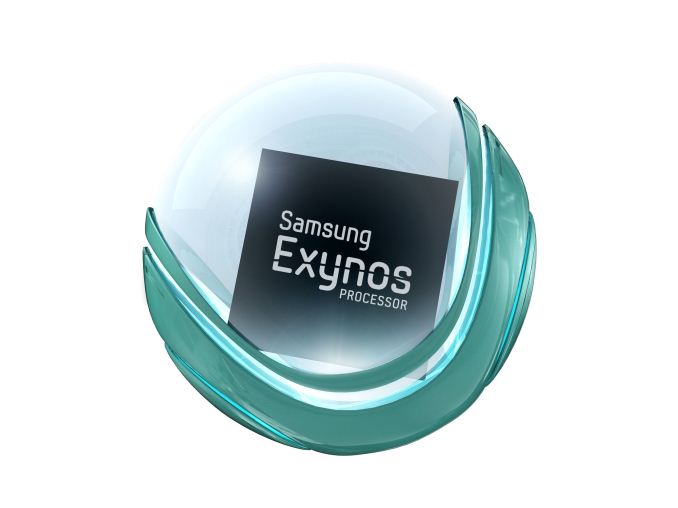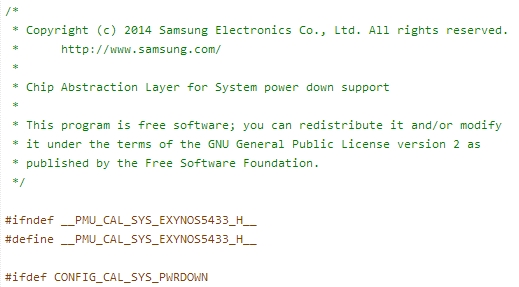Samsung's Exynos 5433 is an A57/A53 ARM SoC
by Andrei Frumusanu on September 16, 2014 11:40 AM EST- Posted in
- SoCs
- Samsung
- Arm
- exynos 5 octa
- Cortex A53
- Cortex A57
- ARMv8
- Exynos 5433

There has been a lot of confusion going on over the last few weeks on what exactly Samsung's Exynos 5433 is. Joshua and I were pretty much convinced that it was a standard big.LITTLE A15/A7 chip configuration due to naming consistencies and evidence in firmware. Even though the Note 4 was already announced with region-specific models employing this chip, Samsung S.LSI has yet to divulge any kind of official information on the matter or even publicly announce the chip.
With the release of new source code, we can now confirm that the Exynos 5433 is indeed the first Cortex A57/A53 SoC to market. We see a 4x Cortex A57, 4x Cortex A53 big.LITTLE CPU configuration employed in the part, here's a little overview of what we currently know:
| Samsung Exynos 5 Octa 2014 lineup | ||||
| SoC | Samsung Exynos 5422 |
Samsung Exynos 5430 |
Samsung Exynos 5433 |
|
| CPU |
4x Cortex A7 r0p5 @ 1.3GHz 4x Cortex A15 r2p4 @ 1.9GHz |
4x Cortex A7 r0p5 @ 1.3GHz 4x Cortex A15 r3p3 @ 1.8GHz |
4x Cortex A53 @ 4x Cortex A57 r1p0 @ |
|
| Memory Controller |
2x 32-bit @ 933MHz 14.9GB/s b/w |
2x 32-bit @ 1066MHz 17.0GB/s b/w |
2x 32-bit @ 825MHz 13.2GB/s b/w |
|
| GPU | Mali T628MP6 @ 533MHz |
Mali T628MP6 @ 600MHz |
Mali T760MP6 @ 700MHz |
|
| Mfc. Process |
Samsung 28nm HKMG |
Samsung 20nm HKMG |
Samsung 20nm HKMG |
|
The big question is why Samsung choose to name this chip Exynos 5433 and not market it as a 64-bit chip in a new product lineup? The answer could be simply that we won't ever see the 5433 running in AArch64 mode. The chip's firmware and drivers are running on a "CAL" / Chip-Abstraction-Layer on the lowest level of the driver stacks. In fact, beyond the CPU cores (and GPU), the Exynos 5433 looks very similar to the Exynos 5430 which employs A15/A7 cores.
While we won't be seeing the Exynos 5433 running 64-bit code any time soon, it still takes advantage of the architectural improvements of ARM's Cortex A57 and A53 cores and their ARMv8 instruction set (running in AArch32 mode). Power consumption should also be improved due to the new A50's power management and new retention features. The silicon, similarly to the 5430, is manufactured on Samsung's new 20nm process.

Atlas (A57) and Apollo (A53) cores in the power management drivers
Also employed for the first time is ARM's new Mali T760 GPU running at 700MHz. We already published an architectural dive into the T760 detailing what's new. I wasn't able to determine the number of cores on this GPU due to ARM's transparent and scalable driver architecture in regards to shader cores, this is something we'll have to wait for in the eventual official announcement or in a hands-on investigation. OpenCL information points out to 6 compute units, hence we can derive an MP6 configuration on the Mali (Shoutout to Lodix for his findings).
While the Exynos 5433 seems nothing more than a "brain-transplant" in terms of SoC design, the newer Exynos 7 chip is a genuinely new part. Over the last 3 weeks Samsung has been busy submitting patches to the Linux kernel mailing lists adding support for their new SoC lineup. The Exynos 7420 seems to be on track for Samsung's next flagship lineup, this time in full 64-bit AArch64 mode with Android L. The details of the chip are still sparse, but we'll be seeing the same A57/A53 CPU combination together with an Mali T760, powered by an LPDDR4-capable memory controller.
The Exynos 5433 is definitely a surprise that many didn't expect. Qualcomm's Snapdragon 810 isn't officially due until Q1 2015, and we don't know yet when we'll be seeing it in consumer devices. Here Samsung has quite a lead as the Note 4 variants with the 5433 are shipping in the coming weeks. While I'm still a bit perplexed at Samsung's silence and lack of announcements, the fact that many regions are supplied a Snapdragon S805 in the Note 4 may have to do something with it, as they wouldn't want to cause buyer's remorse.
Edit 22/10/2014: Mali MP6 configuration has been confirmed.











41 Comments
View All Comments
heartinpiece - Tuesday, September 16, 2014 - link
Why on earth did they decide to lower the memory controller frequency (leading to bandwidth drop?)This'll sacrifice GPU performance as well as CPU performance...
Andrei Frumusanu - Tuesday, September 16, 2014 - link
The Mali's T760's AFBC feature should provide a lot of room to bandwidth utilization. We still don't know the real-world effect until we test it out, but don't dismiss the chip's bandwidth quite yet.http://www.anandtech.com/show/8234/arms-mali-midga...
GC2:CS - Tuesday, September 16, 2014 - link
It is powering QHD !Unless there is some "Crystalwell" cache inside like in Apple A7 (which I heavily doubt) it just won't be enough.
MrCommunistGen - Tuesday, September 16, 2014 - link
Getting A53/A57 to production as quickly as possible, Samsung may have had some issues in their first production revision design or with the manufacturing itself. This could also be a reason for not running AArch64(?). Perhaps the chips aren't fully functional in that regard. Rather than letting the chips go to waste, might as well sell them in a few select markets, right?Also, they've been making and tuning the A15/A7 memory controllers for quite some time and across multiple manufacturing processes. I imagine they've got that optimized pretty well. As their first A57/A53 memory controllers on the also new 20nm node I imagine they still have quite a bit of performance tweaking they can do to improve memory bandwidth down the line.
MrCommunistGen - Tuesday, September 16, 2014 - link
Posted before finishing my thought...5430 was likely a "clearing the pipes" chip for the 20nm process using the very familiar A15/A7 designs. It fits in the product stack and is certainly a nice "last hurrah" for A15. Less aggressive clocks on a smaller process also help ensure its not constantly thermally throttling.
Similarly, 5433 could also be their "clearing the pipes" chip for 20nm + A57/53 ahead of a more wholehearted launch of Exynos 7xxx down the road.
coburn_c - Wednesday, September 17, 2014 - link
Well hopefully memory bandwidth isn't a problem, because LPDDR4 is still using 32bit channels. Between that and the power overhead I doubt throughput will increase much throughout this generation.AppleCrappleHater2 - Tuesday, September 23, 2014 - link
Exynos chips have always tended to outperform Snapdragons released at about the same time.Problem is that Cortex-A15 has been a dud in terms of power consumption, which is why it hasn't been seen in anything but a small percentage of mainline phones. Even in tablets where its poor power efficiency is less of an issue, Qualcomm Kraits have been dominating.
The truth is - at peak performance, Krait is far more power efficient than the A15, which means that it takes longer for a Krait to hit thermal throttling limits and it can run for longer on battery. What's the point of having that insane peak performance if you can't sustain it without overheating or killing the battery?
Snapdragons didn't have such a clear advantage when it came to Scorpion vs. Cortex-A9, or even dual-Krait vs. quad-A9 which is why Exynos 4210 and 4412 dominated Samsung's handset lineup in their heyday - but the A15 has been a failure outside of the tablet and Chromebook market.
Samsung will claim the reason for Krait dominating their handset lineup is LTE in public documentation, but the Note 2 and international LTE GS3 (I9305) proved that Samsung can hang a Qualcomm LTE modem off of an Exynos CPU.
ddriver - Tuesday, September 16, 2014 - link
I see samsung is still very dedicated to strangling its chip with narrow 64 bit memory bus. 13.2 GB/sec - that's quite the step back from the 5430, seems like samsung intends to starve those powerful cores so that in a few months it can release yet another "faster" chip without breaking too much sweat at R&D instead of doing the smart thing and launch A57 products with 128bit memory bus from the start.GC2:CS - Tuesday, September 16, 2014 - link
Anybody who expected samsung to deliver a fully thought 64-bit solution is rather foolish.The are rushing to 64-bit as fast as they can, look a this chip, a great example ! They used alpha as an experiment to kick up the 20nm process a bit and then they swapped the cores for those 64-bit ones, they don't mind to improve anything else over the 5430.
Death666Angel - Tuesday, September 16, 2014 - link
So they are taking a page out of Intels book? Or AMDs (4770 for 40nm)? How is that a bad thing? Do minor architectural changes for process shrinks and to major architectural changes on the same process.